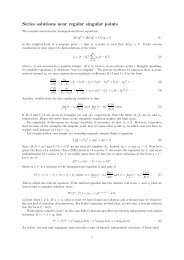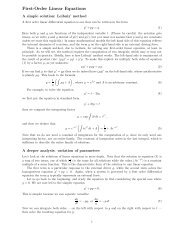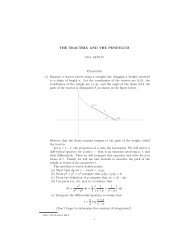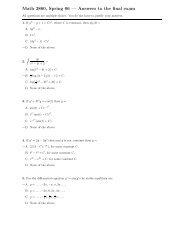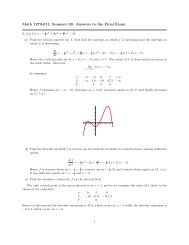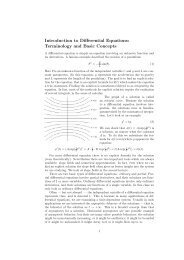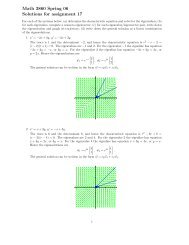Evaluating real integrals using the Residue Theorem - The Live Toad
Evaluating real integrals using the Residue Theorem - The Live Toad
Evaluating real integrals using the Residue Theorem - The Live Toad
Create successful ePaper yourself
Turn your PDF publications into a flip-book with our unique Google optimized e-Paper software.
EVALUATING REAL INTEGRALS<br />
USING THE RESIDUE THEOREM<br />
PR HEWITT<br />
All examples taken from chapter 7 of Complex Variables and Applications,<br />
8th edition, by James Brown and Ruel Churchill.<br />
Problem 6, page 267. We start with a simple example which never<strong>the</strong>less<br />
illustrates <strong>the</strong> general strategy. We wish to evaluate<br />
(1)<br />
To do this we first evaluate<br />
where<br />
and C R is <strong>the</strong> contour<br />
∫ ∞<br />
−∞<br />
∫<br />
f(z) =<br />
dx<br />
x 2 + 2x + 2<br />
C R<br />
f(z) dz<br />
1<br />
z 2 + 2z + 2<br />
<strong>the</strong>n take <strong>the</strong> limit as R → ∞. To obtain our final result we show that <strong>the</strong><br />
contribution to <strong>the</strong> integral from <strong>the</strong> semicircle A R tends to 0.<br />
Date: 27 March 2013.<br />
1
2 PR HEWITT<br />
First we evaluate <strong>the</strong> contour integral <strong>using</strong> <strong>the</strong> <strong>Residue</strong> <strong><strong>The</strong>orem</strong>. Since<br />
z 2 + 2z + 2 = (z + 1) 2 + 1 we see that <strong>the</strong>re is exactly one singularity interior<br />
to <strong>the</strong> contour, namely a simple pole at z = −1 + i. Hence<br />
∫<br />
f(z) dz = 2πi · Res f(z) = 2πi · 1<br />
C z=−1+i R<br />
2(−1 + i) + 2 = π<br />
Now we need to estimate |f(z)| when |z| = R. <strong>The</strong>re are several ways to do<br />
this. Using an idea from a previous exercise we note that if z 2 +2z +2 = z 2 w<br />
<strong>the</strong>n<br />
w = 1 + 2 z + 2 → 1 as z → ∞.<br />
z2 Hence we may choose an R so that |w| ≥ 1 2<br />
when |z| ≥ R. In this range we<br />
find that<br />
|f(z)| ≤ 1<br />
1<br />
≤ 2 when |z| ≥ R<br />
2 |z|2 R2 Hence<br />
∫<br />
lim<br />
R→∞<br />
∣ f(z) dz<br />
∣ ≤ πR · 2<br />
A R<br />
R 2 → 0 as R → ∞<br />
When we put this all toge<strong>the</strong>r we find that<br />
∫ ∞<br />
−∞<br />
∫<br />
dx<br />
∞<br />
x 2 + 2x + 2 = P. V.<br />
−∞<br />
dx<br />
x 2 + 2x + 2<br />
∫<br />
= lim f(z) dz<br />
R→∞ I<br />
(∫<br />
R<br />
∫ )<br />
= lim f(z) dz − f(z) dz<br />
R→∞ C R A<br />
( ∫ ) R<br />
= lim<br />
R→∞<br />
π − f(z) dz<br />
A R<br />
= π − 0.<br />
We can check our work directly, without recourse to complex variables,<br />
by making <strong>the</strong> substitution u = x + 1 in (1):<br />
∫ b<br />
a<br />
∫<br />
dx<br />
b+1<br />
∣<br />
x 2 + 2x + 2 = du<br />
∣∣∣<br />
b+1<br />
u 2 + 1 = arctan(u)<br />
as a → −∞ and b → +∞.<br />
a+1<br />
a+1<br />
→ 1 2 π − − 1 2 π
REAL INTEGRALS AND RESIDUES 3<br />
Problem 8, pages 267–268. We are asked to evaluate<br />
(2)<br />
∫ ∞<br />
0<br />
dx<br />
x 3 + 1<br />
<strong>The</strong> book suggests taking f(z) = 1/(z 3 + 1) and integrating f along <strong>the</strong><br />
contour<br />
This will proceed along <strong>the</strong> same lines as above, <strong>using</strong> <strong>the</strong> <strong>Residue</strong> <strong><strong>The</strong>orem</strong><br />
and demonstrating that <strong>the</strong> contribution to <strong>the</strong> integral from <strong>the</strong> circular arc<br />
tends to 0. <strong>The</strong> main difference is <strong>the</strong> extra segment J R : <strong>the</strong> contribution<br />
from this segment is significant, and so we must parametrize it carefully and<br />
study <strong>the</strong> integral <strong>the</strong>re.<br />
Again <strong>the</strong>re is only one singularity inside <strong>the</strong> contour, and that is a simple<br />
pole at e iπ/3 . Hence<br />
∫<br />
C R<br />
f(z) dz = 2πi ·<br />
Res f(z) = 2πi ·<br />
z=e iπ/3<br />
1<br />
3(e iπ/3 ) 2 = i 2 2π/3<br />
3πe−i When |z| = R > 1 <strong>the</strong> Triangle Inequality tells us that<br />
1<br />
|f(z)| ≤<br />
R 3 − 1<br />
whence ∣∫<br />
∣∣∣ f(z) dz<br />
∣ ≤ 2 3 πR · 1<br />
A R<br />
R 3 → 0 as R → ∞.<br />
− 1<br />
Now <strong>the</strong> new and interesting bit. Along J R we take <strong>the</strong> parametrization<br />
z = re i 2π/3 for 0 ≤ r ≤ R. This parametrizes J R backwards, hence<br />
∫<br />
∫<br />
∫ R<br />
e i 2π/3 ∫<br />
dr<br />
f(z) dz = − f(z) dz = −<br />
J R −J R 0 r 3 + 1<br />
= −ei 2π/3 f(z) dz.<br />
I R
4 PR HEWITT<br />
When we put all this toge<strong>the</strong>r we find that<br />
i 2 3 πe−i 2π/3 = (1 − e i 2π/3 )<br />
∫<br />
f(z) dz +<br />
I R<br />
∫<br />
f(z) dz.<br />
A R<br />
If we take <strong>the</strong> limit as R → ∞ and divide both sides by 1 − e i 2π/3 we<br />
conclude that<br />
∫ ∞<br />
0<br />
dx<br />
x 3 + 1 =<br />
i 2π<br />
3(e i 2π/3 − e −i 2π/3 ) = π<br />
3 sin(2π/3) = 2π<br />
3 √ 3<br />
This integral can also be done without recourse to <strong>the</strong> <strong>Residue</strong> <strong><strong>The</strong>orem</strong>,<br />
by factoring x 3 + 1 as (x + 1)(x 2 − x + 1) and <strong>the</strong>n applying <strong>the</strong> standard<br />
techniques from Callc II — partial fractions, trig substitution, etc. I will<br />
leave this as an exercise.<br />
Problem 7, page 276. We now do a simple application of Jordan’s Lemma.<br />
We are asked to evaluate<br />
(3)<br />
∫ ∞<br />
−∞<br />
x sin x dx<br />
(x 2 + 1)(x 2 + 4)<br />
Notice that <strong>the</strong> integrand is even. Hence<br />
We take<br />
∫ ∞<br />
−∞<br />
∫<br />
x sin x dx<br />
∞<br />
(x 2 + 1)(x 2 + 4) = Im P. V.<br />
f(z) =<br />
−∞<br />
z<br />
(z 2 + 1)(z 2 + 4)<br />
x e ix dx<br />
(x 2 + 1)(x 2 + 4)<br />
and integrate f(z)e iz over <strong>the</strong> contour below and apply Jordan’s Lemma to<br />
<strong>the</strong> integral over <strong>the</strong> semicircle.
REAL INTEGRALS AND RESIDUES 5<br />
Inside this contour <strong>the</strong>re are two singularities, simple poles at i and 2i.<br />
Hence<br />
∫<br />
(<br />
)<br />
f(z)e iz dz = 2πi · Res<br />
C z=i f(z)eiz + Res<br />
z=2i f(z)eiz R<br />
(<br />
ie −1<br />
= 2πi ·<br />
2i · (−1 + 4) + 2ie −2 )<br />
(−4 + 1) · 4i<br />
π(e − 1)<br />
= i<br />
3e 2 .<br />
When |z| = R > 2 we find that<br />
R<br />
|f(z)| ≤<br />
(R 2 − 1)(R 2 → 0 as R → ∞.<br />
− 4)<br />
Hence by Jordan’s Lemma we have<br />
∫<br />
f(z)e iz dz → 0 as R → ∞.<br />
A R<br />
If we put this all toge<strong>the</strong>r <strong>the</strong>n we conclude<br />
∫ ∞<br />
∫<br />
x sin x dx<br />
−∞ (x 2 + 1)(x 2 = Im lim f(z)e iz dz<br />
+ 4) R→∞ I<br />
(∫<br />
R<br />
∫<br />
)<br />
= Im lim f(z)e iz dz − f(z)e iz dz<br />
R→∞ C R A R<br />
π(e − 1)<br />
= Im(i<br />
3e 2 − 0)<br />
π(e − 1)<br />
=<br />
3e 2
6 PR HEWITT<br />
Problem 1, page 286. We are asked to evaluate<br />
∫ ∞<br />
cos(ax) − cos(bx)<br />
(4)<br />
0 x 2 dx<br />
Note that<br />
cos(az)<br />
z 2 = 1 z 2 − a 2 + · · ·<br />
and thus<br />
cos(az) − cos(bz)<br />
z 2 = b − a + · · ·<br />
2<br />
which is entire! <strong>The</strong>re will be no residues to compute if we integrate this<br />
function.<br />
Instead we integrate<br />
f(z) = eiaz − e ibz<br />
z 2 = i a − b + · · · ,<br />
z<br />
which has a simple pole at 0, and <strong>the</strong>n look at <strong>the</strong> <strong>real</strong> part. <strong>The</strong> complication<br />
is that this function is singular at a point along <strong>the</strong> natural contour<br />
for this problem — in fact <strong>the</strong> improper integral near 0 diverges. So we<br />
take an “indented contour” to ensure that <strong>the</strong> integrand is analytic along<br />
<strong>the</strong> contour:<br />
By <strong>the</strong> <strong>Residue</strong> <strong><strong>The</strong>orem</strong> we have that<br />
∫<br />
C R<br />
f(z) dz = 0.<br />
Since 1/|z| 2 = 1/R 2 along A R Jordan’s Lemma (applied twice) tells us<br />
that<br />
∫<br />
A R<br />
f(z) dz → 0 as R → ∞
REAL INTEGRALS AND RESIDUES 7<br />
Along J we take <strong>the</strong> parametrization z = −x for ρ ≤ x ≤ R and find that<br />
∫<br />
∫<br />
∫ R<br />
e −iax − e −ibx<br />
f(z) dz = − f(z) dz = −<br />
(−dx)<br />
Hence<br />
J<br />
∫<br />
I+J<br />
−J<br />
ρ<br />
x 2<br />
∫ R<br />
cos(ax) − cos(bx)<br />
f(z) dz = 2<br />
ρ x 2 dx<br />
It remains to study what happens to <strong>the</strong> integral along Γ ρ as ρ → 0. Here<br />
we meet an old friend in a new guise. Let us consider a slightly more general<br />
situation. Suppose that g(z) has a simple pole at z 0 with residue B, and we<br />
integrate g along circular arc of small radius ρ:<br />
Near z 0 we have that<br />
g(z) =<br />
B<br />
z − z 0<br />
+ h(z)<br />
where h(z) is analytic. For sufficiently small ρ we have (say)<br />
|h(z)| ≤ |h(z 0 )| + 1<br />
whence<br />
∫<br />
h(z) dz<br />
∣ Γ ρ<br />
∣ ≤ (β − α)ρ · (|h(z 0)| + 1) → 0 as ρ → 0<br />
This yields<br />
∫<br />
lim<br />
ρ→0<br />
∫ β<br />
g(z) dz = lim<br />
Γ ρ ρ→0 α<br />
B · iρe iθ dθ<br />
ρe iθ<br />
∫<br />
+ lim h(z) dz = i (β − α)B<br />
ρ→0 Γ ρ<br />
When α = 0 and β = 2π we recover <strong>the</strong> essential computation in <strong>the</strong> proof of<br />
<strong>the</strong> <strong>Residue</strong> <strong><strong>The</strong>orem</strong>. In our case we have α = π, β = 0, and B = i(a − b).
8 PR HEWITT<br />
If we put all this toge<strong>the</strong>r <strong>the</strong>n we obtain<br />
∫ ∞<br />
∫<br />
cos(ax) − cos(bx)<br />
1<br />
0 x 2 dx = lim<br />
ρ→0, R→∞ 2<br />
∫<br />
1<br />
= − lim<br />
ρ→0 2<br />
I+J<br />
f(z) dz<br />
Γ ρ<br />
f(z) dz − lim<br />
R→∞<br />
= − 1 2i (−π) · i (a − b) − 0<br />
Problem 3, page 286. We are asked to use <strong>the</strong> function<br />
to evaluate <strong>the</strong> <strong>integrals</strong><br />
(5)<br />
f(z) = z1/3 log z<br />
z 2 + 1<br />
, − 1 2 π < arg z < 3 2 π<br />
∫ ∞<br />
0<br />
3√ ∫ x ln x<br />
∞ 3√ x<br />
x 2 + 1 dx and x 2 + 1 dx<br />
0<br />
∫<br />
1<br />
f(z) dz<br />
2 A R<br />
Two for <strong>the</strong> price of one! As with <strong>the</strong> previous example we will use what<br />
<strong>the</strong> text calls an “indented contour”, but in this case we will be eschewing<br />
a branch cut, not an isolated singularity. <strong>The</strong> limit calculations will be very<br />
different for <strong>the</strong> indentation.<br />
We use <strong>the</strong> same contour as above:<br />
When R is large and ρ is small <strong>the</strong> enclosed region contains exactly one<br />
singularity, namely a simple pole at i. Hence<br />
∫<br />
C<br />
f(z) dz = 2πi · Res<br />
z=i f(z) = 2πi · i1/3 log i<br />
2i<br />
= i π2<br />
2 eiπ/6
REAL INTEGRALS AND RESIDUES 9<br />
Now we need to estimate <strong>the</strong> contributions to <strong>the</strong> integral from A and Γ.<br />
When |z| = r we find that<br />
Hence<br />
and<br />
|f(z)| ≤ r1/3 (| ln r| + 3 2 π)<br />
|r 2 − 1|<br />
∫<br />
∣ f(z) dz<br />
∣ ≤ πR · R1/3 (ln R + 3 2 π)<br />
A R<br />
R 2 → 0 as R → +∞<br />
− 1<br />
∣ ∣∣∣∣ ∫<br />
f(z) dz<br />
Γ ρ<br />
∣ ≤ πρ · ρ1/3 (− ln ρ + 3 2 π)<br />
1 − ρ 2 → 0 as ρ → 0 +<br />
by L’Hospital’s Rule.<br />
Thus, in <strong>the</strong> limit, all of <strong>the</strong> action is along I and J. We can parametrize<br />
J backwards <strong>using</strong> z = −x for ρ ≤ x ≤ R. Along this segment we have that<br />
−x = e iπ x. Thus<br />
∫<br />
J<br />
∫<br />
f(z) dz = −<br />
−J<br />
= e iπ/3 ∫ R<br />
ρ<br />
∫ R<br />
e iπ/3 3√ x (ln x + iπ)<br />
f(z) dz = −<br />
ρ x 2 + 1<br />
3√ x ln x<br />
x 2 + 1 dx + i πeiπ/3 ∫ R<br />
ρ<br />
3√ x<br />
x 2 + 1 dx<br />
When we put all <strong>the</strong>se <strong>integrals</strong> toge<strong>the</strong>r we find that<br />
∫ ∫<br />
∫ ∫<br />
i π2<br />
2 eiπ/6 = f(z) dz + f(z) dz + f(z) dz +<br />
I<br />
= (1 + e iπ/3 )<br />
J<br />
∫ R<br />
ρ<br />
∫<br />
+ f(z) dz +<br />
Γ<br />
0<br />
Γ<br />
3√ ∫ x ln x<br />
R<br />
x 2 + 1 dx + i πeiπ/3 ρ<br />
∫<br />
f(z) dz<br />
A<br />
A<br />
(−dx)<br />
f(z) dz<br />
3√ x<br />
x 2 + 1 dx<br />
If we take limits as ρ → 0 and R → +∞, <strong>the</strong>n divide both sides by e iπ/6<br />
<strong>the</strong>n we obtain<br />
∫ ∞ 3√ ∫<br />
i π2<br />
x ln x<br />
∞ 3√ x<br />
2 = 2 cos(π/6) x 2 + 1 dx + i πeiπ/6 x 2 + 1 dx<br />
If we look at <strong>the</strong> <strong>real</strong> and imaginary parts of <strong>the</strong> above equation we find<br />
that<br />
√<br />
∫ ∞ 3√ x ln x<br />
3<br />
0 x 2 + 1 dx = π ∫ ∞ 3√ x<br />
2 0 x 2 + 1 dx<br />
π 2<br />
2 = π√ ∫<br />
3 ∞ 3√ x<br />
2 x 2 + 1 dx<br />
which lead to <strong>the</strong> answers given in <strong>the</strong> text.<br />
0<br />
0
10 PR HEWITT<br />
Problem 6, page 291. Finally we show how we can sometimes use residues<br />
to evaluate ordinary (that is, not improper) <strong>integrals</strong> by making a substitution<br />
that transforms <strong>the</strong> <strong>real</strong> integral into a contour integral. For example,<br />
to compute<br />
(6)<br />
∫ π<br />
0<br />
dθ<br />
(a + cos θ) n , a > 1.<br />
we use <strong>the</strong> substitution<br />
Thus<br />
where<br />
z = e iθ , dz = i e iθ dz = iz dz, cos θ = 1 2 (z + z−1 ).<br />
∫ π<br />
0<br />
dθ<br />
(a + cos θ) n = 1 ∫ 2π<br />
dθ<br />
2 0 (a + cos θ) n<br />
= 1 ∫<br />
dz<br />
2 iz(a + 1 2 (z + z−1 )) n<br />
= 2n−1<br />
i<br />
= 2n−1<br />
i<br />
|z|=1<br />
∫<br />
∫<br />
|z|=1<br />
|z|=1<br />
r, s = −a ± √ a 2 − 1.<br />
z n−1 dz<br />
(z 2 + 2az + 1) n<br />
z n−1 dz<br />
(z − r) n (z − s) n<br />
Since r < −1 we find that <strong>the</strong> only singularity in <strong>the</strong> circle is a pole of order<br />
n is <strong>the</strong> root s = 1/r. Thus<br />
∫ π<br />
0<br />
dθ<br />
(a + cos θ) n = z n−1<br />
2n π · Res<br />
z=s (z − r) n (z − s) n<br />
We expand z n−1 /(z − r) n in a Laurent series around s:<br />
z n−1 (z − s + s)n−1<br />
=<br />
(z − r) n (s − r + z − s) n<br />
=<br />
n−1<br />
1 ∑<br />
(s − r) n<br />
×<br />
j=0<br />
( n − 1<br />
j<br />
∞∑<br />
( ) −n (z − s)<br />
k<br />
k (s − r) k<br />
k=0<br />
)<br />
s j (z − s) n−1−j
Hence<br />
∫ π<br />
dθ<br />
(a + cos θ) n = 2n n−1<br />
π ∑<br />
(s − r) n<br />
0<br />
REAL INTEGRALS AND RESIDUES 11<br />
l=0<br />
( n − 1<br />
= 2n n−1<br />
π ∑<br />
( n − 1<br />
(s − r) n l<br />
=<br />
l=0<br />
2 n n−1<br />
π ∑<br />
(s − r) 2n−1<br />
l=0<br />
l<br />
( n − 1<br />
)( −n<br />
l<br />
) ( s<br />
s − r<br />
)( n + l − 1<br />
l<br />
) l<br />
) l<br />
) ( −s<br />
l s − r<br />
)( ) n + l − 1<br />
(−s) l (s − r) n−l−1<br />
l<br />
Note that −s = a − √ a 2 − 1 and s − r = 2 √ a 2 − 1. Thus when n = 2 we<br />
obtain<br />
4π<br />
(<br />
8(a 2 − 1) 3/2 2 √ a 2 − 1 + 2(a − √ )<br />
a 2 πa<br />
− 1) =<br />
(a 2 − 1) 3/2<br />
When n = 3 we obtain<br />
8π<br />
(<br />
32(a 2 − 1) 5/2 4(a 2 − 1) + 6(a − √ a 2 − 1) · 2 √ a 2 − 1 + 6(a − √ a 2 − 1) 2)<br />
What is <strong>the</strong> pattern for arbitrary n?<br />
= π(4a2 + 2)<br />
4(a 2 − 1) 5/2



